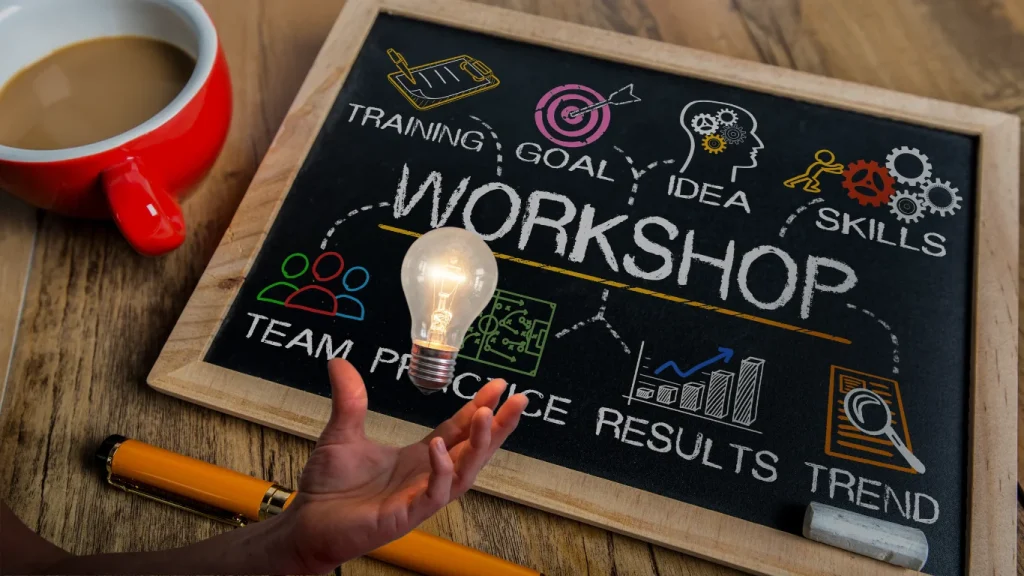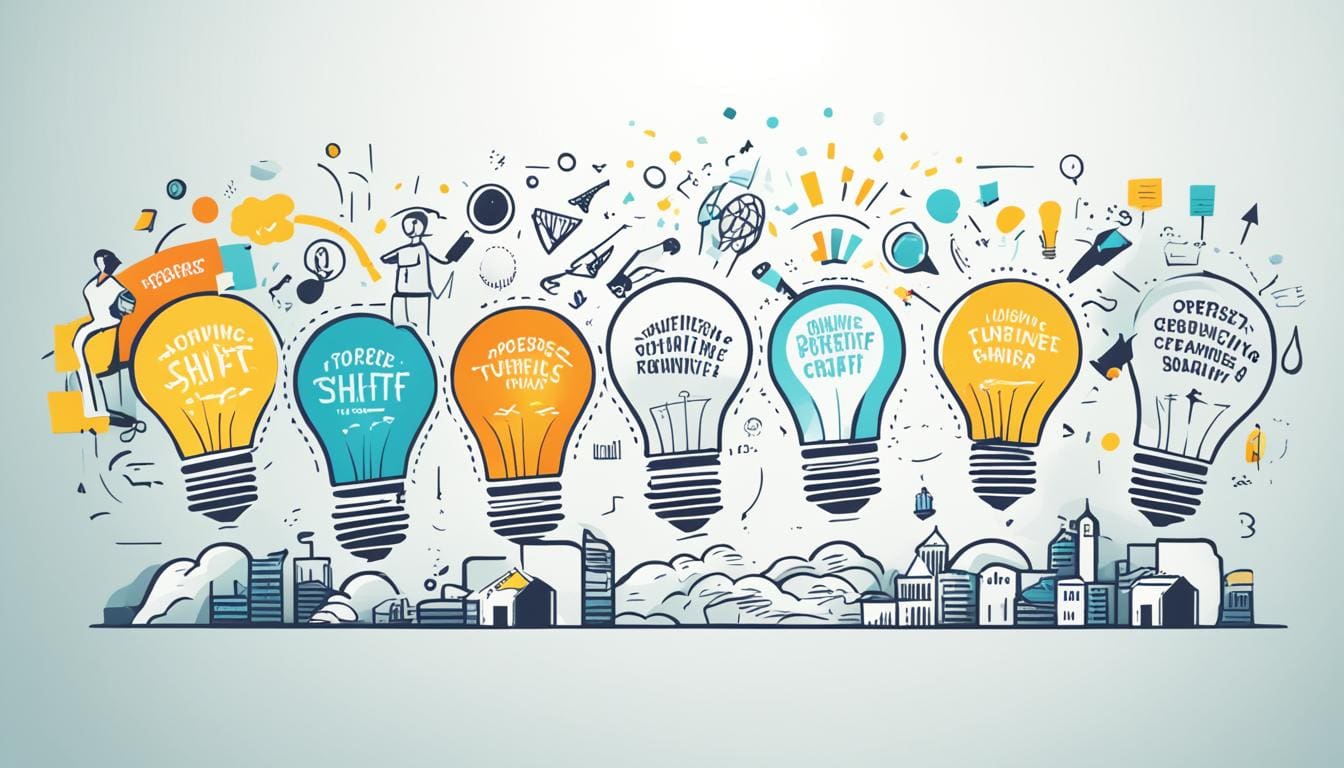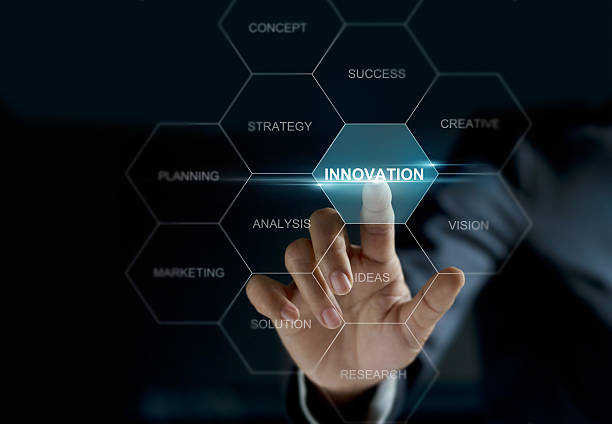Innovative workshops One of the most important tools that institutions and companies rely on in their pursuit of developing new ideas and stimulating creativity within work teams is that these are not merely group meetings, but rather stimulating environments that generate unconventional solutions and open new horizons for excellence and development.
But the fundamental question remains: how do we know if these workshops are truly effective?
Do they lead to tangible and applicable results, or are they just brainstorming sessions that end without any real impact?
In this comprehensive guide, we will review an integrated methodology for performance evaluation. Innovative workshops In a practical way that helps institutions ensure they get the most out of every workshop, turning ideas into real achievements that enhance performance and support sustainable growth.
In addition, we will discuss the most prominent tools and challenges facing the evaluation process, with examples from major international companies.
The importance of evaluating innovative workshops
Before starting any evaluation process, it is important to understand Why is evaluating innovative workshops a fundamental necessity and not a secondary option?
The evaluation is not just to measure how successful the workshop was in generating new ideas, but it is a way to understand the real impact it had on the participants, on the work environment, and on the company’s results.
Therefore, the assessment represents a crucial step to ensure the sustainability of the innovation culture in the organization.
Measuring the actual impact of the workshop
Evaluation helps determine whether the workshop achieved tangible results, such as developing viable ideas or finding solutions to real problems facing the organization. The success of a workshop is measured by the extent to which ideas are transformed into real projects, not by the number of sheets of paper filled with notes.
Moreover, Accurate measurement of impact enables management to make smarter decisions about investing in future workshops.
Improving the quality of future workshops
Through evaluation, strengths and areas for improvement in the workshop can be identified, allowing for further development of the experience in future workshops. Each workshop is an opportunity for continuous learning and improvement of organizational and administrative methodologies.
For example, If the level of interaction proves to be weak, more dynamic methods can be adopted in subsequent workshops.
Enhancing employee engagement
When participants see that their views and recommendations are taken into account and seriously analyzed, they feel valued, which increases their enthusiasm to participate in future workshops and fosters a spirit of collective innovation.
Conversely, the absence of evaluation weakens the sense of importance of participation.
Achieving a return on investment
Innovative workshops require time, effort, and financial resources, so it is essential to ensure that the resulting return is worth the investment.
Therefore, a good evaluation helps companies to know whether the workshop has achieved real added value or not, and at the same time it shows the areas that can be improved to maximize the benefit.
Methodology for evaluating innovative workshops
For the evaluation to be effective, it must be carried out in a systematic and organized manner that includes all stages of the workshop: before it is held, during its implementation, and after it is completed.
Through this methodology, the organization can measure the impact objectively and clearly.
Setting goals before the workshop
Every innovative workshop should begin with clear and measurable goals.
Ask yourself: What is the purpose of this workshop? Is the goal to develop a new product? Or to improve internal processes? Or to find solutions to specific challenges?
Once the goal is defined, it can be set Success criteria Tangible, such as:
- Number of new ideas proposed.
- The quality of the solutions and their feasibility.
- Level of participant engagement.
- The results are consistent with the strategic goals of the organization.
In addition, setting these criteria in advance helps to build an objective evaluation framework that facilitates measurement later.
Performance evaluation during the workshop
Evaluation is not limited to final results, but should begin From inside the workshop itself, during the activities and sessions.
On the other hand, Monitoring the interaction in real time helps in adjusting the facilitation style if necessary.
Analysis of the level of interaction and participation
The level of individual participation is an important indicator of workshop effectiveness. It can be measured by:
- Number of active participants in group discussions.
- The quality and diversity of the ideas presented.
- The extent of interaction between teams and groups.
- The degree of enthusiasm and positivity shown by the attendees.
It is also possible, For example, Record the number of entries in each activity and compare them with the final outputs.
Using real-time measurement tools
To analyze performance during the workshop, digital tools such as Mentimeter or Slido, which allows for instant surveys and the collection of participants’ opinions in real time.
In addition, the facilitation team can observe the body language and emotions of the participants and their level of practical engagement with the activities.
In this way, an accurate picture of the level of participation is obtained.
Documenting observations and ideas
It is important to record all observations and ideas raised during the workshop. This data forms the basis upon which performance evaluation will be built later.
Indeed, good documentation ensures that no idea or detail that may be useful later is lost.
Evaluate the results after the workshop ends
After the workshop ends, the most important stage in the evaluation process begins, which is the analysis. Quality of output and long-term impact.
Therefore, the organization ensures that the results are realistic and not just theoretical ideas.
Output quality analysis
The success of the workshop is measured by how realistic and applicable the ideas it produced are.
The outputs can be evaluated based on:
- The number of feasible ideas compared to the total number of ideas proposed.
- Clarity of vision in implementation plans.
- The extent to which the proposals are compatible with the organization’s current capabilities.
Moreover, Comparing the results to previous workshops shows the extent of the progress in performance.
Collecting participants’ opinions
It is preferable to send an electronic survey after the workshop to measure participants’ satisfaction with the experience.
Tools like Google Forms or Typeform can be used to ask questions such as:
- What did you like most about the workshop?
- Did you feel that the workshop added new knowledge to your knowledge?
- What aspects can be improved next time?
In fact, this step is very important because it provides realistic insights from within the experience itself.
In addition, the results can be analyzed to identify common patterns in the observations.
Long-term impact assessment
After a period of time has passed since the workshop (for example, from two weeks to two months), its results should be monitored to determine:
- How many of the ideas were actually implemented?
- How much do these ideas affect the organization’s performance?
- Did the workshop contribute to fostering a culture of innovation within the team?
This step then enables management to measure the true value of the workshop in the long term.
Practical tools and methods for evaluating innovative workshops
To ensure effective evaluation, a range of Practical tools and methodologies that facilitate the measurement and analysis process.
At the same time, these tools help to link data to actionable results.
Key Performance Indicators (KPIs)
Performance indicators are a key tool for evaluating the outcomes of innovation workshops. Some of the most important include:
- Idea implementation rate:
(Number of ideas implemented ÷ Total number of ideas proposed) × 100%. - Participants’ satisfaction level: measured on a scale of 1 to 10.
- Organizational performance improved: by comparing performance indicators before and after the workshop.
In addition, these indicators can be used to determine future priorities in training programs.
The “Before & After” approach
This method is used to compare the situation before and after the workshop.
It begins by identifying existing problems or weaknesses, then measuring the extent of improvement or change achieved thanks to the workshop.
For example, If productivity was low before the workshop and improved afterward, this is clear evidence of its success.
SCAMPER Innovation Assessment Model
The SCAMPER model is one of the most effective tools for assessing the quality of ideas generated from a workshop.
It is based on seven analytical steps:
- Substitution: Can an element or method be substituted to improve the outcome?
- Combination: Can two or more ideas be combined to create a new solution?
- Adaptation: How can an idea be modified to suit the work context?
- Modify: What can be improved in the idea?
- Reuse (Put to Another Use): Can the idea be applied in another field?
- Elimination: Are there elements that can be deleted to simplify the solution?
- The opposite (Reverse): What if the order or approach were reversed? Would that result in better innovation?
Through this model, the team is able to look at ideas from multiple angles, thus ensuring access to more creative and effective solutions.
Common challenges in evaluating innovative workshops and their solutions
The evaluation process may encounter some difficulties, especially in environments that do not have an organized evaluation culture.
However, overcoming these challenges is possible through good planning and the use of effective tools.
Weak participation of some individuals
Some participants may hesitate to express their ideas.
Solution: Use techniques such as written brainstorming or divide participants into small groups to increase interaction.
In addition, the facilitator can encourage everyone to participate through open and stimulating questions.
Difficulty in measuring the actual impact
It can sometimes be difficult to link the ideas generated from the workshop to tangible improvements in performance.
Solution: Follow up on the implementation of the ideas in the medium term and document their impact with figures and results.
For example, Performance indicators can be compared before and after the proposed solutions are implemented.
Insufficient data for assessment
The organization may face a problem in collecting accurate information after the workshop.
the solution: Develop a plan in advance to collect data from the beginning, such as feedback forms and documentation of implementation phases.
Therefore, the assessment becomes more accurate and based on objective facts.
Examples of global companies that effectively evaluate their innovation workshops
The experiences of some of the world’s leading companies show that systematic evaluation is one of the secrets to the success of their innovation workshops.
Indeed, monitoring performance and analyzing results has helped these companies establish a culture of innovation at all levels.
The Sprint methodology is used Which focuses on testing prototypes in just 5 days, then evaluating the results through real-world tests with users.
Moreover, The company relies on rapid data analysis to make immediate decisions regarding product development.
IDEO
IDEO relies It involves collecting feedback from users immediately after the workshops, evaluating ideas based on real-world experience, and building improvements based on customer behavior.
Conversely, internal review sessions are also used to improve the experience of subsequent workshops.
Amazon
Amazon takes over Great importance is placed on implementing ideas, and workshops are evaluated based on how the results impact customer experience, not just internal creativity.
Therefore, this practical approach makes its workshops a real tool for improving overall performance.
Evaluating innovative workshops is the path to real results.
Evaluating the performance of innovative workshops It is not a formal procedure, but rather an essential element to ensure that the effort put into thinking and planning translates into tangible results.
By setting goals in advance, monitoring interaction during the workshop, and analyzing the outputs afterwards, companies can build a strong innovation culture that achieves sustainable growth.
Moreover, Adopting an integrated assessment approach helps create a stimulating and supportive work environment for creativity.
A successful workshop is not one that fills the board with ideas, but one that transforms ideas into real achievements that change the way we work and open up new opportunities for creativity and development.
Reins: Your partner in professionally organizing and evaluating innovative workshops
Are you planning to organize an innovation workshop within your organization?
Let the Reins team help you design a unique experience that combines creativity with tangible results.
We offer integrated solutions that include workshop design, session management, and performance evaluation to ensure maximum value is derived from every idea presented.
In addition, we offer modern analysis and evaluation tools that help you turn ideas into measurable results.
With Reins, innovation workshops will not be just an internal activity, but a strategic step towards developing a work environment that stimulates creativity and excellence.
📩 Contact us today to begin your journey towards effective corporate innovation!













